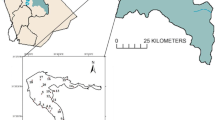Abstract
A preliminary assessment of the Wujiangdu Reservoir examined nutrient distribution and transport. Water samples were collected in the summer (July) of 2004, during the high-flow season. Inorganic nutrients (N, P, Si) and chlorophyll a (chl a) concentrations of the Wujiangdu Reservoir and its inflow rivers were analyzed. Other water parameters (dissolved oxygen, pH, temperature, and electrical conductivity) were measured as well. The results show gradually decreasing concentrations of NO3 −-N and dissolved silicate in the surface water moving downstream to the dam of the Wujiangdu Reservoir. Additionally, soluble reactive phosphorus concentrations measured very low, with most falling below the sensitivity threshold of the method used in surface waters. Particulate phosphorus and NO3 −-N were the predominant species of phosphorus and nitrogen in the reservoir, respectively. The concentration of nutrients in the Yeji River was the largest of all inflow rivers. The maximum concentration of chl a was found near the dam. These results reflect upstream conditions similar to that of a river, and reservoir conditions near the dam similar to that of a natural lake system.



Similar content being viewed by others
References
Bellanger B, Huon S, Steinmann P et al (2004) Oxic-anoxic conditions in the water column of a tropical freshwater reservoir. Appl Geochem 19(8):1295–1314
Degens ET, Kempe S, Richey JE (1991) Biogeochemistry of major world rivers. Wiley, New York
Friedl G, Teodoru C, Wehrli B (2004) Is the Iron Gate I reservoir on the Danube River a sink for dissolved silica? Biogeochemistry 68:21–32
Han GL, Liu CQ (2004) Water geochemistry controlled by carbonate dissolution: a study of the river waters draining karst-dominated terrain, Guizhou Province, China. Chem Geol 204:1–21
Hooper RP, Aulenbach BT, Kelly VJ (2001) The national stream quality accounting network: a flux-based approach to monitoring the water quality of large rivers. Hydrol Process 15(7):1089–1106
Humborg C, Blomqvist S, Avsan E et al (2002) Hydrological alterations with river damming in northern Sweden: implications for weathering and river biogeochemistry. Global Biogeochem Cycles 16(3):1–13
Humborg C, Pastuszak M, Aigars J et al (2006) Decreased silica land-sea fluxes through damming in the Baltic Sea catchment—significance of particle trapping and hydrological alterations. Biogeochemistry 77:265–281
Humborg C, Smedberg E, Medina MR et al (2008) Changes in dissolved silicate loads to the Baltic Sea—the effects of lakes and reservoirs. J Mar Syst 73(3–4):223–235
Hungspreugs M, Utoomprurporn W, Sompongchaiyakul P et al (2002) Possible impact of dam reservoirs and river diversions on material fluxes to the Gulf of Thailand. Mar Chem 79:185–191
Hwang SJ (1998) A study on the water quality improvement and effective management plan for a large impounding lake in Kyonggi Province, Pyungtaek Lake (in Korean). Research report, 1998, 98-17, Kyonggi Development Institute, pp 1–142
Jossette G, Leporcq B, Sanchez N et al (1999) Biogeochemical mass-balances (C, N, P, and Si) in three large reservoirs of the Seine Basin (France). Biogeochemistry 47:119–146
Liang X, Fu W et al (1998) Investigation on nutrient elements and organic pollutants of Baihua and Hongfeng Lake. Guizhou Sci 16(4):311–315 (in Chinese)
Matzinger A, Pieters R, Ashley K et al (2007) Effects of impoundment on nutrient availability and productivity in lakes. Limnol Oceanogr 52(6):2629–2640
Meybeck M (1982) Carbon, nitrogen, and phosphorus transport by world rivers. Am J Sci 282(4):401–450
Milliaman JD (1997) Blessed dams or damned dams? Nature 386:325–327
Pan H, Wang Y, Dong Y (1999) Factor analysis of eutrophication in Erhai Lake. Lake Sci 11(2):184–188 (in Chinese)
Pápista ÉK, Ács É, Böddi B (2002) Chlorophyll-a determination with ethanol—a critical test. Hydrobiologia 485:191–198
State Environmental Protection Bureau, Compiling Committee for Monitoring and Analytical Methods of Water and Waste Water (2002) Monitoring and analytical methods of water and waste water, IV edn. Environmental Science Press of China, Beijing (in Chinese)
Su WC (2002) Negative effects of cascade hydropower exploitation environmental in the Wujiang basin. Res Environ Yangtze Basin 11(4):338–392 (in Chinese)
Teodoru C, Mcginnis DF, Wüest A et al (2006) Nutrient retention in the Danube’s Iron Gate reservoir. EOS Trans Am Geophys Union 87(38):385–400
Vörösmarty CJ, Meybeck M, Fekete B et al (2003) Anthropogenic sediment retention: major global impact from registered river impoundments. Global Planet Change 39:169–190
Wang FS, Yu YX, Liu CQ et al (2010) Dissolved silicate retention and transport in cascade reservoirs in Karst area, Southwest China. Sci Total Environ 408:1667–1675
Wei GL, Yang ZF, Cui BS et al (2009) Impact of dam construction on water quality and water self-purification capacity of the Lancang river, China. Water Resour Manag 23(9):1763–1780
Yu YX, Liu CQ, Wang FS et al (2008) Dissolved inorganic carbon and its isotopic differentiation in cascade reservoirs in the Wujiang drainage basin. Chin Sci Bull 53(21):3371–3378
Zhu J, Liu CQ, Wang YC et al (2006) Spatiotemporal variation of dissolved silicon in Wujiangdu reservoir. Adv Water Sci 17(3):330–333 (in Chinese)
Acknowledgements
The authors thank Pr. LIU Cong-qiang for his kindly guidance, Dr. ZHU Zhao-zhou, Dr. WEI Zhong-qing and Dr. LI Jun for their careful assistance in field sampling. This research was funded by the Ministry of Science and Technology of China through Grant No. 2016YFA0601000, the Natural Science Foundation of China (No. 423456700), youth fund from the Sichuan provincial education department (2006B077), basic research program from Sichuan Province of technology (2008JY0121), educational reform program of Neijiang Teachers College (JG200912-162), and self key scientific research program of Sichuan provincial education department (14ZA0247).
Author information
Authors and Affiliations
Corresponding author
Rights and permissions
About this article
Cite this article
Zhu, J., Li, S., Wang, Y. et al. Spatial characters of nutrients in Wujiangdu Reservoir in karst river, SW China. Acta Geochim 36, 605–610 (2017). https://doi.org/10.1007/s11631-017-0246-3
Received:
Revised:
Accepted:
Published:
Issue Date:
DOI: https://doi.org/10.1007/s11631-017-0246-3




